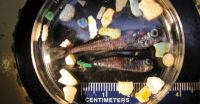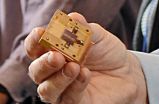(Press-News.org) The first scientific results from an ambitious voyage led by a group of graduate students from Scripps Institution of Oceanography at UC San Diego offer a stark view of human pollution and its infiltration of an area of the ocean that has been labeled as the "Great Pacific Garbage Patch."
Two graduate students with the Scripps Environmental Accumulation of Plastic Expedition, or SEAPLEX, found evidence of plastic waste in more than nine percent of the stomachs of fish collected during their voyage to the North Pacific Subtropical Gyre. Based on their evidence, authors Peter Davison and Rebecca Asch estimate that fish in the intermediate ocean depths of the North Pacific ingest plastic at a rate of roughly 12,000- to 24,000 tons per year.
Their results were published June 27 in the journal Marine Ecology Progress Series.
During the SEAPLEX voyage in August 2009, a team of Scripps graduate students traveled more than 1,000 miles west of California to the eastern sector of the North Pacific Subtropical Gyre aboard the Scripps research vessel New Horizon. Over 20 days the students, New Horizon crew and expedition volunteers conducted comprehensive and rigorous scientific sampling at numerous locations. They collected fish specimens, water samples and marine debris at depths ranging from the sea surface to thousands of feet depth (See SEAPLEX Oceanographic Equipment).
Of the 141 fishes spanning 27 species dissected in the study, Davison and Asch found that 9.2 percent of the stomach contents of mid-water fishes contained plastic debris, primarily broken-down bits smaller than a human fingernail. The researchers say the majority of the stomach plastic pieces were so small their origin could not be determined.
"About nine percent of examined fishes contained plastic in their stomach. That is an underestimate of the true ingestion rate because a fish may regurgitate or pass a plastic item, or even die from eating it. We didn't measure those rates, so our nine percent figure is too low by an unknown amount," said Davison.
The authors say previous studies on fish and plastic ingestion may have included so-called "net-feeding" biases. Net feeding can lead to artificially high cases of plastic ingestion by fishes while they are confined in a net with a high concentration of plastic debris. The Scripps study's results were designed to avoid such bias. The highest concentrations of plastic were retrieved by a surface collecting device called a "manta net," which sampled for only 15 minutes at a time. The short sampling time minimizes the risk of net feeding by preventing large concentrations of plastic from building up, and also by reducing the amount of time that a captured fish spends in the net. In addition to the manta net, the fishes were also collected with other nets that sample deeper in the water column where there is less plastic to be ingested through net feeding.
The new study focused on the prevalence of plastic ingestion, but effects such as toxicological impacts on fish and composition of the plastic were outside of the study's goals.
The majority of fish examined in the study were myctophids, commonly called lanternfish because of their luminescent tissue. Lanternfishes are hypothesized to use luminescence for several purposes, including counter-illumination (thwarts predators attempting to silhouette the lanternfish against sunlight), mate attraction and identification and illumination of prey. Such fish generally inhabit the 200- to 1,000-meter (650- to 3,280-foot) depth during the day and swim to the surface at night.
"These fish have an important role in the food chain because they connect plankton at the base of the food chain with higher levels. We have estimated the incidence at which plastic is entering the food chain and I think there are potential impacts, but what those impacts are will take more research," said Asch.
Rather than a visible "patch" or "island" of trash, marine debris is highly dispersed across thousands of miles of the North Pacific Subtropical Gyre. The debris area cannot be mapped from air or space, so SEAPLEX researchers collected samples in 132 net tows (130 of which contained plastic) across a distance of more than 2,375 kilometers (1,700 miles) in an attempt to find the boundaries of the patch. The region, a "convergence zone" where floating debris in water congregates, is generally avoided by mariners due to its calm winds and mild currents. The North Pacific Subtropical Gyre has been understudied by scientists, leaving many open questions about marine debris in the area and its long-term effects on the marine environment.
"This study clearly emphasizes the importance of directly sampling in the environment where the impacts may be occurring," said James Leichter, a Scripps associate professor of biological oceanography who participated in the SEAPLEX expedition but was not an author of the new paper. "We are seeing that most of our prior predictions and expectations about potential impacts have been based on speculation rather than evidence and in many cases we have in fact underestimated the magnitude of effects. SEAPLEX also clearly illustrates how relatively small amounts of funding directed for novel field sampling and work in remote places can vastly increase our knowledge and understanding of environmental problems."
INFORMATION:
SEAPLEX was supported by the UC Ship Funds program, Project Kaisei/Ocean Voyages Institute and the National Science Foundation.
Note to broadcast and cable producers: University of California, San Diego provides an on-campus satellite uplink facility for live or pre-recorded television interviews. Please phone or e-mail the media contact listed above to arrange an interview.
About Scripps Institution of Oceanography
Scripps Institution of Oceanography at University of California, San Diego, is one of the oldest, largest and most important centers for global science research and education in the world. Now in its second century of discovery, the scientific scope of the institution has grown to include biological, physical, chemical, geological, geophysical and atmospheric studies of the earth as a system. Hundreds of research programs covering a wide range of scientific areas are under way today in 65 countries. The institution has a staff of about 1,400, and annual expenditures of approximately $170 million from federal, state and private sources. Scripps operates robotic networks, and one of the largest U.S. academic fleets with four oceanographic research ships and one research platform for worldwide exploration. Birch Aquarium at Scripps serves as the interpretive center of the institution and showcases Scripps research and a diverse array of marine life through exhibits and programming for more than 415,000 visitors each year. Learn more at scripps.ucsd.edu.
Scripps study finds plastic in 9 percent of 'garbage patch' fishes
SEAPLEX researchers estimate tens of thousands of tons of debris annually ingested by fish in middle ocean depths of North Pacific Ocean
2011-07-01
ELSE PRESS RELEASES FROM THIS DATE:
Newberry South Carolina Hotel Provides Nearby Accommodations for Guests Attending the July 4th Fireworks Extravaganza
2011-07-01
The Holiday Inn Express & Suites Newberry South Carolina Hotel offers convenient lodging to guests attending Newberry's July 4th Fireworks Extravaganza. The festivities will take place at Newberry High School, located at 3113 Main Street. This is a fun family event with music provided by the group Still Cruisin', games for the kids, and food vendors. The activities and entertainment begin at 6pm, and fireworks will light up the sky at dusk.
The Holiday Inn Express & Suites is the top place to stay among other Newberry South Carolina hotels. The 4 story interior ...
A different kind of mentor
2011-07-01
MADISON, WI, JUNE 30, 2011 -- Mentoring is a recognized tool in career development and advancement. It brings a personal element to what might otherwise be a confusing process. Mentors can provide insight into the unwritten rules and culture of the professional workplace. With the click of a mouse, a student can have access to an ementor, a career professional who can expand the student's career horizon and help navigate their collegiate experience.
An ementoring program was designed in 2002 for first-time freshmen in animal science, conducted within a required freshmen ...
Scientists hope to get glimpse of adolescent universe from revolutionary instrument-on-a-chip
2011-07-01
Scientists know what the universe looked like when it was a baby. They know what it looks like today. What they don't know is how it looked in its youth. Thanks to technological advances, however, scientists hope to complete the photo album and provide a picture of how the cosmos developed into the kind of place that could support life like that found on Earth.
They plan to gather these never-before-obtained insights with a potentially "game-changing" instrument that is expected to be 10,000 times more sensitive than the current state-of-the-art.
The instrument is being ...
Kirstie and Phil Launch House Hunter App
2011-07-01
Kirstie Allsopp and Phil Spencer, the TV property gurus, have launched new research revealing UK home hunters overspent their combined budgets by a staggering GBP3.7 billion last year, despite falling house prices and what should be a buyers' market.
The survey of 2,000 home buyers, announced to coincide with the launch of the new iPhone app 'Kirstie & Phil's House Hunter', has revealed that almost half (49 per cent) blow their budget on average to the tune of over GBP10,000.
For one in ten home buyers (10 per cent) the situation is even more extreme, with finances ...
NASA's LRO mission gets a sunrise view of Tycho crater's peak
2011-07-01
On June 10, 2011, NASA's Lunar Reconnaissance Orbiter spacecraft pointed the LRO Camera NACs to capture a dramatic sunrise view of Tycho crater.
A very popular target with amateur astronomers, Tycho is located at 43.37°S, 348.68°E, and is about 51 miles (82 km) in diameter. The summit of the central peak is 1.24 miles (2 km) above the crater floor. The distance from Tycho's floor to its rim is about 2.92 miles (4.7 km).
Many rock fragments ("clasts") ranging in size from some 33 feet (10 m) to hundreds of yards are exposed in the central peak slopes. Were these distinctive ...
Confused.com Designs New Pothole Warning Sign
2011-07-01
Confused.com has designed a new road sign, specifically to alert road users to the UK's two million potholes*. The road sign is the first of its kind and the car insurance expert is petitioning to urge the Department for Transport to introduce it to roads across the UK.
A constant source of frustration for drivers, the sign has been developed in response to recent findings that even with sufficient budgets; it would take councils at least 11 years to repair the UK's damaged roads**. With this in mind, 82% of drivers would like to see a road sign dedicated to potholes. ...
Study uncovers novel genetic variation linked to increased risk of sudden cardiac arrest
2011-07-01
LOS ANGELES – June 30, 2011 – A study by a global consortium of physician-scientists has identified a genetic variation that may predispose people to double the risk of having a sudden cardiac arrest, a disorder that gives little warning and is fatal in about 95 percent of cases. Although previous, smaller studies have identified some genes with a potential association with sudden cardiac arrest, this is the first study large enough to enable scientists to apply results to the general population. Findings are published today by the Public Library of Science (PloS Genetics).
"We ...
Georgetown research identifies key reasons racial disparities exist in emergent stroke treatment
2011-07-01
Washington, DC – African-Americans are less likely than whites to receive critical stroke treatment primarily because they do not get to a hospital soon enough for time-sensitive treatment and because of preexisting medical conditions. For patients who are eligible for treatment, no racial disparity was found.
Those are the findings of a new Georgetown University Medical Center study involving the review of almost 1,000 patient records from all seven acute care hospitals in Washington, DC. The new study will be published in the June 30th issue of American Stroke Association's ...
Happy Employees Need a Voice Says Reed.co.uk
2011-07-01
Whilst pay, perks and a pleasant working environment all score highly, being kept in the loop with high levels of communication is the single most important factor in keeping UK workers content within their jobs.
The survey conducted by reed.co.uk, which polled more than 2,500 UK workers, revealed that strong communication (87% of respondents), opportunities for career advancement (86%) and job security (85%) are amongst the most important factors contributing to staff happiness, whilst training (81%) and recognition of a job well done (77%) also influence job satisfaction. ...
Women win out in gastrointestinal surgery
2011-07-01
In the first study to consider the impact of gender on patient outcomes in major gastrointestinal surgeries, researchers at UC San Diego Health System have found that women are more likely to survive after the procedure than men. The pattern is even more pronounced when comparing women before menopause with men of the same age.
Results, now published online in the Journal of Surgical Research in a paper titled "The Battle of the Sexes: Women Win Out in Gastrointestinal Surgery," shed light on major differences between patients which impact treatment success, and open ...
LAST 30 PRESS RELEASES:
Can community awareness campaigns in low-resource areas improve early diagnosis of colorectal cancer?
Stardust study resets how life’s atoms spread through space
Practical education: Clinical scenario-based program development
The impact of family dynamics on eating behaviour – how going home for Christmas can change how you eat
Tracing the quick synthesis of an industrially important catalyst
New software sheds light on cancer’s hidden genetic networks
UT Health San Antonio awarded $3 million in CPRIT grants to bolster cancer research and prevention efforts in South Texas
Third symposium spotlights global challenge of new contaminants in China’s fight against pollution
From straw to soil harmony: International team reveals how biochar supercharges carbon-smart farming
Myeloma: How AI is redrawing the map of cancer care
Manhattan E. Charurat, Ph.D., MHS invested as the Homer and Martha Gudelsky Distinguished Professor in Medicine at the University of Maryland School of Medicine
Insilico Medicine’s Pharma.AI Q4 Winter Launch Recap: Revolutionizing drug discovery with cutting-edge AI innovations, accelerating the path to pharmaceutical superintelligence
Nanoplastics have diet-dependent impacts on digestive system health
Brain neuron death occurs throughout life and increases with age, a natural human protein drug may halt neuron death in Alzheimer’s disease
SPIE and CLP announce the recipients of the 2025 Advanced Photonics Young Innovator Award
Lessons from the Caldor Fire’s Christmas Valley ‘Miracle’
Ant societies rose by trading individual protection for collective power
Research reveals how ancient viral DNA shapes early embryonic development
A molecular gatekeeper that controls protein synthesis
New ‘cloaking device’ concept to shield sensitive tech from magnetic fields
Researchers show impact of mountain building and climate change on alpine biodiversity
Study models the transition from Neanderthals to modern humans in Europe
University of Phoenix College of Doctoral Studies releases white paper on AI-driven skilling to reduce burnout and restore worker autonomy
AIs fail at the game of visual “telephone”
The levers for a sustainable food system
Potential changes in US homelessness by ending federal support for housing first programs
Vulnerability of large language models to prompt injection when providing medical advice
Researchers develop new system for high-energy-density, long-life, multi-electron transfer bromine-based flow batteries
Ending federal support for housing first programs could increase U.S. homelessness by 5% in one year, new JAMA study finds
New research uncovers molecular ‘safety switch’ shielding cancers from immune attack
[Press-News.org] Scripps study finds plastic in 9 percent of 'garbage patch' fishesSEAPLEX researchers estimate tens of thousands of tons of debris annually ingested by fish in middle ocean depths of North Pacific Ocean



